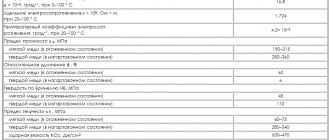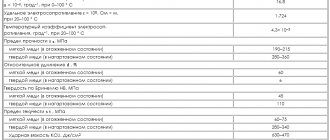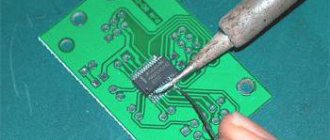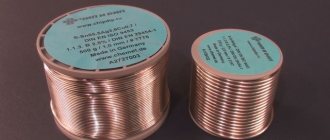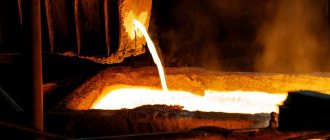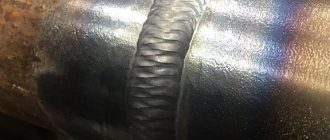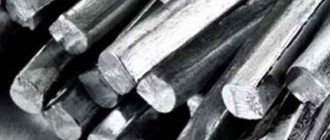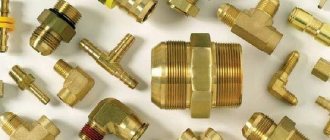TECHNICAL REQUIREMENTS
2.1. Tin-lead solders in products are manufactured in accordance with the requirements of this standard according to technological instructions approved in the prescribed manner. The chemical composition of tin-lead solders must comply with the requirements of GOST 21930. (Changed edition, Amendment No. 1, 2).
2.2. The surface of rods, wires, tapes and tubes should be free of foreign inclusions, cracks and delaminations. Separate unopened air bubbles that do not have slag inclusions are allowed on the surface of rods, wire and tape. (Changed edition, Amendment No. 2, 3).
2.3. There should be no foreign inclusions in the broken wire, rod, tape or tube. (Changed edition, Amendment No. 2).
2.4. Pine rosin according to GOST 19113 is used as a flux (filler) for solder tubes. The flux must be continuous along the entire length of the tube. By agreement between the consumer and the manufacturer, it is allowed to use more active fluxes as a filler. The mass of flux in the tube should be (2.5±0.5)% of the mass of the tube. (Changed edition, Amendment No. 2, 3).
2.5. The physical and mechanical properties of solders are given in Appendix 1 of GOST 21930.
2.6. The areas of primary use of solders are given in Appendix 2 of GOST 21930.
Refractory and low-melting
Solders for soldering are divided into refractory and low-melting.
They are also called hard and soft. All types of solders are widely used in mechanical engineering, electrical engineering, and electronics. Hard solders are used when it is necessary to achieve high joint strength. Probably, such connections could be called constructive. Their melting point reaches 500 ℃ and above.
This temperature is dangerous for most components of electronic circuits, especially for semiconductor devices and limits their use, so other alloys are used for soldering - low-melting alloys.
They are obtained by adding more lead to tin. All low-melting solders have a melting point of about 200 - 240 ℃.
2a. SAFETY REQUIREMENTS
2a.1. The processes of production and soldering (tinning) with tin-lead and tin-lead-cadmium solders may be accompanied by the release of toxic substances of lead and cadmium oxide, which, in accordance with GOST 12.1.007, belong to substances of the 1st hazard class.
2a.2. The entry of harmful substances into the human body during the production and use of solders is possible through inhalation of polluted air, as well as through water and food if workers do not observe personal hygiene. The effect of lead on the human body is to damage the nervous system, blood, and blood vessels. Cadmium affects the respiratory system, gastrointestinal tract, internal organs, skeletal muscles and bone tissue, and causes skin irritation.
2a.3. The maximum permissible concentration of lead in the air of the working area of industrial premises is 0.01 mg/m, cadmium oxide is 0.1 mg/m according to GOST 12.1.005.
2a.4. Monitoring the content of harmful substances in the air of the working area must be carried out in accordance with GOST 12.1.005 and GOST 12.1.007. Air samples are analyzed for lead and cadmium oxide content according to methods approved by the USSR Ministry of Health.
2a.5. The design, equipment and finishing of production premises and workplaces in the manufacture and use of lead-containing alloys must comply with the safety rules for the production of tin and alloys based on it, approved by the State Mining and Technical Supervision Authority of the USSR, and the sanitary rules for organizing the soldering of small products with alloys containing lead, approved by the Ministry of Health of the USSR.
2a.6. During loading and unloading operations, safety requirements must be observed in accordance with GOST 12.3.009 and safety rules for enterprises and organizations of the metallurgical industry, approved by the State Mining and Technical Supervision of the USSR.
2a.7. Safety requirements for the operation of industrial containers manufactured in accordance with GOST 14861 are in accordance with GOST 12.3.010.
2a.8. Safety requirements for determining the chemical composition are in accordance with GOST 1429.0.
2a.9. Those working with solders must undergo: safety instructions in accordance with GOST 12.0.004; training in methods of working with lead- and cadmium-containing solders and rules for handling protective equipment; preliminary upon entry to work and periodic medical examinations.
2a.10. Prevention of lead poisoning when working with solders - according to regulatory documentation approved by the USSR Ministry of Health.
2a.11. All work with molten tin-lead solders must be carried out in dry protective clothing and safety equipment. When working with molten tin-lead solders, servicing tinning and soldering baths, working with solder powder and transport and warehouse work, workers must use personal respiratory protection equipment - ShB-1 “Lepestok” respirators in accordance with GOST 12.4.028. To avoid burns, those working with molten solders must protect their faces with head shields in accordance with GOST 12.4.023.
2a.12. Those working with tin-lead solders must be provided with household premises in accordance with SNiP 2.09.04 for group of production processes IIIa. In sanitary premises, conditions must be created for workers to observe the rules of personal hygiene. (Changed edition, Amendment No. 3). Section 2. (Introduced additionally, Amendment No. 1).
With a melting point less than 200 degrees
There are also solders with very low melting points. This is, for example, POSK-50-18. From the marking it follows that this solder contains 50% tin, 18% cadmium, and 32% lead.
This solder melts at a temperature of 142 – 145 ℃. It is very plastic, but due to its cadmium content, it is toxic.
Another example of such low-melting solders is POSV-50 (it has the name Rose). Here the number 50 indicates a bismuth content of 50%, and tin and lead are present in the composition in equal proportions - 25% each.
Solder melting temperature is 90 – 94 ℃. These two soldering products most often come in tablet-like shape and size. Wood's third alloy contains 10% tin, 40% lead, 40% bismuth, 10% cadmium.
Its melting point does not exceed 72°C. Due to the presence of cadmium in its composition, it is toxic. Rose and Wood alloys are quite expensive.
Indium solders are often used for soldering semiconductors, since their melting point is about 117 ℃. In this alloy, indium replaces tin, and lead is also added to soften it and make it more fluid.
Some indium solders can be used to solder glass. In this case, the edges of the latter are simply rubbed with paste before soldering.
ACCEPTANCE RULES
3.1. Solders are accepted in batches. Each batch must consist of solders of the same brand, type and size. The mass of the party is not limited. The batch must be documented in one quality document containing: trademark or name and trademark of the manufacturer; solder symbol; batch number; chemical analysis results; net and gross mass of the batch in kilograms; date of manufacture; (Changed edition, Amendment No. 1, 2, 3).
3.2. Each skein, coil and 0.5% of rods by weight of the batch are subjected to inspection and measurement.
3.3. To control the chemical composition of the solder, 0.3% (by weight) of coils of wire, tubes with a diameter of up to 2.5 mm, and tapes with a thickness of up to 2.5 mm are selected from the batch; 0.05% (by weight) of coils of wire, tubes with a diameter of more than 2.5 mm and tape with a thickness of more than 2.5 mm and tape with a thickness of more than 2.5 mm,* but not less than two coils; 0.03% (by weight) of rods, but not less than five rods. _________________ * The text corresponds to the original. — Note "CODE". To check the chemical and granulometric composition of the powder, 20% of the cans, but not less than five cans, are selected from the batch. (Changed edition, Amendment No. 2).
3.4. If unsatisfactory test results are obtained for at least one of the indicators, repeated tests are carried out on a double sample taken from the same batch. The results of repeated tests apply to the entire batch.
ASSORTMENT
1. ASSORTMENT
1.1. The wire diameters and maximum deviations along them must correspond to those indicated in Table 1. (Changed edition, Amendment No. 1, 2, 3).
1.2. The diameters of round rods, the dimensions of the sides of triangular and square rods and the maximum deviations for them must correspond to those indicated in Table 2. (Changed edition, Amendment No. 3).
Table 1
mm
| Nominal wire diameter | Maximum deviation |
| 0,4 | ±0,05 |
| 0,5 | ±0,05 |
| 0,6 | ±0,06 |
| 0,8 | ±0,08 |
| 0,95 | ±0,08 |
| 1,0 | ±0,10 |
| 1,2 | ±0,10 |
| 1,5 | ±0,10 |
| 1,8 | ±0,10 |
| 2,0 | ±0,10 |
| 2,5 | ±0,12 |
| 3,0 | ±0,15 |
| 3,5 | ±0,17 |
| 4,0 | ±0,17 |
| 5,0 | ±0,17 |
| 6,0 | ±0,18 |
| 7,0 | ±0,20 |
table 2
mm
| Round rods | Triangular rods | Square bars | |||
| Nominal diameter | Maximum deviation | Side Size | Maximum deviation | Side Size | Maximum deviation |
| 8 | ±0,24 | 10 | ±0,30 | 5 | ±0,25 |
| 10 | ±0,30 | 12 | ±0,36 | 7 | ±0,35 |
| 12 | ±0,36 | 14 | ±0,42 | 9 | ±0,45 |
| 11 | ±0,55 | ||||
| 15 | ±0,45 | 16 | ±0,48 | 13 | ±0,55 |
| 40 | ±1,2 | 15 | ±0,55 | ||
1.3. The length of the rods should be (400±20) mm. The difference in the length of the rods in a pack should be no more than 10 mm. (Changed edition, Amendment No. 2).
1.4. The dimensions of the tapes must correspond to those indicated in Table 3, the maximum deviations of the sizes of the tapes are in Table 4.
Table 3
mm
| Nominal tape thickness | Nominal belt width |
| 0,8 | 8-10 |
| 1,0 | |
| 1,5 | 5-10; 15 |
| 2,0 | |
| 2,5 | |
| 3,0 | |
| 4,0 | |
| 5,0 |
Table 4
mm
| Nominal tape thickness | Maximum deviation | Nominal belt width | Maximum deviation |
| 0,8 | ±0,08 | 5,0 | ±0,5 |
| 1,0 | ±0,10 | 6,0 | ±0,6 |
| 1,5 | ±0,10 | 7,0 | ±0,7 |
| 2,0 | ±0,10 | 8,0 | ±0,8 |
| 2,5 | ±0,10 | 9,0 | ±0,9 |
| 3,0 | ±0,12 | 10,0 | ±1,0 |
| 4,0 | ±0,16 | 15,0 | ±1,0 |
| 5,0 | ±0,20 |
1.5. The diameters of the tubes and the maximum deviations of the outer diameter must correspond to those indicated in Table 5.
Table 5
mm
| Nominal tube outer diameter | Maximum deviation of outer diameter |
| 1,0 | ±0,05 |
| 1,5 | ±0,07 |
| 2,0 | ±0,07 |
| 2,5 | ±0,07 |
| 3,0 | ±0,09 |
| 3,5 | ±0,1 |
| 4,0 | ±0,12 |
| 5,0 | ±0,15 |
(Changed edition, Amendment No. 1, 3).
1.6. By agreement between the consumer and the manufacturer, it is possible to manufacture products of other shapes and sizes.
1.7. The length of the piece of wire and tube must be at least 20 m, the length of the tape - at least 10 m. (Changed edition, Amendment No. 1).
1.8. The granulometric composition of the solder powder must correspond to that indicated in Table 6.
Table 6
| Grid number according to GOST 6613 | Remaining powder on the sieve, %, no more | Passage of powder through a sieve, %, not less |
| 008 | 0,5 | — |
| 0071 | — | 80 |
The symbol for solders is indicated according to the following diagram:
With the following abbreviations: names of the profile assortment: wire - Prv; rod - Fri; tape - L; tube - T; powder - Por; section shapes: round - KR; square - KB; triangular - TRG. An “X” is placed in place of the missing indicator.
Examples of symbols
Solder in the form of round wire with a diameter of 2 mm, brand POSSu 61-0.5:
Solder Prv KR2 POSSu 61-0.5 GOST 21931-76
The same, in the form of a square rod with a square side of 9 mm, brand POSSu 40-0.5:
Solder PtKV 9.0 POSSU 40-0.5 GOST 21931-76
The same, in the form of a triangular cross-section rod with a side size of 14 mm, grade POS 61:
Solder PtTRG 14 POS 61 GOST 21931-76
The same, in the form of a tape 0.8 mm thick, 8 mm wide, brand POS 40:
Solder L 0.8×8 POS 40 GOST 21931-76
The same, in the form of a tube with an outer diameter of 5 mm filled with rosin brand POSSu 25-2:
Solder T 5 POSSU 25-2 GOST 21931-76
The same, in the form of powder brand POSSu 30-2:
Solder Por POSSu 30-2 GOST 21931-76
(Changed edition, Amendment No. 1, 2, 3).
TEST METHODS
4.1. Inspection of the surface of rods, wires, tapes, and tubes is carried out without the use of magnifying devices.
4.2. To take a combined sample, segments 30−40 cm long are taken from the ends of coils and coils of wire, tubes, and tape. The sample is obtained by turning the full cross section or by milling a bunch of ends. The rods are milled in three places - in the middle and at both ends. At the manufacturing plant, during the production of tubes and wire, it is allowed to take a sample to determine the chemical composition from the workpieces and distribute the analysis result to batches of various diameters made from these workpieces. In this case, the flux content in the tubes is determined in each batch. When producing products by hot pressing, it is allowed to take samples from the molten metal evenly at the beginning, middle and end of the batch in the form of rods, followed by turning or milling them. The resulting sawdust is mixed, subjected to magnetic separation, and reduced by quartering to obtain a laboratory sample weighing 200 g. The sample is divided into two parts, one of which is sent for chemical analysis, the second is left in case of disagreement in assessing the quality of solders. Before analysis, a laboratory sample from tubular solder must be washed from rosin with alcohol or other solvents. (Changed edition, Amendment No. 1, 2, 3).
4.3. A powder sample is taken with a probe from each selected jar. The probe is lowered to the entire depth of the can at at least three different points. The selected sample is mixed and reduced by quartering. At the manufacturing plant, it is allowed to take a powder sample using an automatic sampler.
4.4. The diameter of rods, wires and tubes is measured in at least two mutually perpendicular directions of the same section using any measuring instrument that provides the specified measurement accuracy.
4.5. To obtain a fracture, the solder is cut to a depth of no more than one-third of the diameter or thickness and broken off along the cut. Inspection of the fracture is carried out without the use of magnifying devices.
4.6. Analysis of the chemical composition of solders is carried out according to GOST 1429.0-GOST 1429.15. It is allowed to determine the chemical composition of solder by other methods that provide the necessary accuracy of determination. In case of disagreement in assessing the chemical composition of solder, its determination is carried out according to GOST 1429.0-GOST 1429.11. (Changed edition, Amendment No. 2).
4.7. The granulometric composition of the powder is determined according to GOST 9723.
4.8. To determine the flux content () in the tube, samples 30−40 cm long are taken from the ends of the selected skeins (coils) and cut into pieces 3−5 cm long. The sample weight should be 140−160 g. The sample is divided into two parts: one part sent for analysis, the other is kept in case of disagreement in assessing the quality of the batch. Samples weighing 20 g are placed in a clean porcelain crucible and heated until completely melted, then thoroughly mixed and cooled. The hardened solder is cleaned of flux, washed in alcohol to remove its residues, dried and weighed to obtain a mass. Flux content () as a percentage is calculated using the formula
.
The arithmetic mean of the test results of three samples is taken as the final result. (Changed edition, Amendment No. 2).
4.9. The continuity of the flux in the tube is ensured by the manufacturing technology. (Introduced additionally, Amendment No. 2).
Tin-lead
Depending on the composition of the alloys, more precisely, on the percentage of components, the names of solder brands are formed.
For example, POS-30. The letters abbreviate the chemical composition - tin-lead solder, and the number indicates the percentage of tin in the composition - 30%.
Alloys containing tin and lead are generally classified as low-melting solders for soldering.
The most common brands are:
- POS-90. Used when the presence of lead is undesirable. These can be various machines and mechanisms intended for the food industry and agricultural sectors. Lead, when combined with certain chemical elements and in the air, emits toxic fumes that are harmful to the health of living organisms.
- POS-60. Universal solder. It is widely used for soldering due to the combination of its good strength characteristics and the temperature to which radioelements are tolerant.
- POS-40. It is used for soldering galvanized iron products. Used in the repair of heating appliances and pipes.
- POS-30. This brand is used for tinning, that is, for applying a layer of tin to the surface in order to give it anti-corrosion properties.
Lead makes the alloy soft and fluid, making soldering easier. A rod with a high lead content (more than 30%) can be easily bent, whereas a pure tin rod can only be bent with great difficulty.
Foreign stamps
There are also foreign-made compounds. They are marked differently, but the mark can determine the composition of the alloy. An example is the Sb62Pb36Ag2 alloy produced by the American company.
It contains 62% tin, 36% lead and 2% silver. Silver is often added to the composition to increase fluidity after the solder has melted.
Another example is a product produced by Canadian. Its marking is SN62/36/2 NC. This material is in the form of a paste and from the marking it follows that its composition is: 62% tin, 36% lead, 2% silver. NC (No Clean) means that the solder balls are contained within a flux gel.
